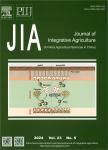Effects of meteorological factors on different grades of winter wheat growth in the Huang-Huai-Hai Plain, China
Effects of meteorological factors on different grades of winter wheat growth in the Huang-Huai-Hai Plain, China作者机构:Institute of Agricultural Resources and Regional PlanningChinese Academy of Agricultural Sciences
出 版 物:《Journal of Integrative Agriculture》 (农业科学学报(英文版))
年 卷 期:2016年第15卷第11期
页 面:2647-2657页
核心收录:
学科分类:0710[理学-生物学] 0832[工学-食品科学与工程(可授工学、农学学位)] 0830[工学-环境科学与工程(可授工学、理学、农学学位)] 1004[医学-公共卫生与预防医学(可授医学、理学学位)] 0905[农学-畜牧学] 09[农学] 0906[农学-兽医学] 0901[农学-作物学] 0703[理学-化学] 0902[农学-园艺学] 0713[理学-生态学]
基 金:financially supported by the National Nonprofit Institute Research Grant of Chinese Academy of Agricultural Sciences(IARRP-2015-8) the European Union seventh framework"MODEXTREME"(modelling vegetation response to extreme events)programme(613817)
主 题:growth condition meteorological factors remote sensing spatiotemporal correlation winter wheat HuangHuai-Hai(HHH) Plain region China
摘 要:The sown area of winter wheat in the Huang-Huai-Hai(HHH) Plain accounts for over 65% of the total sown area of winter wheat in China. Thus, it is important to monitor the winter wheat growth condition and reveal the main factors that influence its dynamics. This study assessed the winter wheat growth condition based on remote sensing data, and investigated the correlations between different grades of winter wheat growth and major meteorological factors corresponding. First, winter wheat growth condition from sowing until maturity stage during 2011–2012 were assessed based on moderate-resolution imaging spectroradiometer(MODIS) normalized difference vegetation index(NDVI) time-series dataset. Next, correlation analysis and geographical information system(GIS) spatial analysis methods were used to analyze the lag correlations between different grades of winter wheat growth in each phenophase and the meteorological factors that corresponded to the phenophases. The results showed that the winter wheat growth conditions varied over time and space in the study area. Irrespective of the grades of winter wheat growth, the correlation coefficients between the winter wheat growth condition and the cumulative precipitation were higher than zero lag(synchronous precipitation) and one lag(pre-phenophase precipitation) based on the average values of seven phenophases. This showed that the cumulative precipitation during the entire growing season had a greater effect on winter wheat growth than the synchronous precipitation and the pre-phenophase precipitation. The effects of temperature on winter wheat growth varied according to different grades of winter wheat growth based on the average values of seven phenophases. Winter wheat with a better-than-average growth condition had a stronger correlation with synchronous temperature, winter wheat with a normal growth condition had a stronger correlation with the cumulative temperature, and winter wheat with a worse-than-average growth condition had a stronger correlation with the pre-phenophase temperature. This study may facilitate a better understanding of the quantitative correlations between different grades of crop growth and meteorological factors, and the adjustment of field management measures to ensure a high crop yield.



